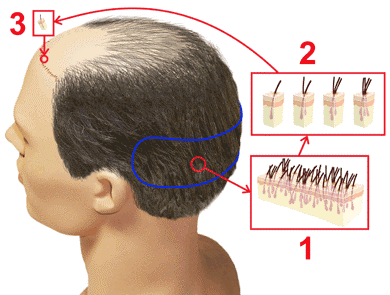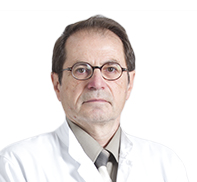- HYGEIA
- Vision & Mission
- Timeline
- Organizational structure
- Press Releases
- Social responsibility
- Awards and Distinctions
- Human Resources
- Scientific & Training activities
- Articles – Publications
- Our Facilities
- Magazines
- Healthcare Programs
- Doctors
- Services
- Medical Divisions & Services
- Imaging Divisions
- Departments
- Units
- Centers of Excellence
- Emergency – Outpatient
- Nursing Service
- Ambulances
- Patients
- Hygeia
- Υπηρεσίες
- Ιατρικά Τμήματα & Υπηρεσίες
Hair Transplant
Τhe Hair Transplant and Restoration Department at Hygeia Hospital is dedicated to the diagnosis and treatment of hair loss but also to its surgical restoration in men and women. It is the first specialized hair clinic in a private hospital. The experience of many years in transplants but also the number of thousands of operations we have realized in Greece and abroad over the last years have ranked us as one of the major Hair Transplantation Centers in Europe.
Characteristic feature of the group of doctors of the clinic is the know-how of surgical hair restoration, the sincere assessment of the options available to face the problem that a patient has, and the high aesthetic perception in the performance of hair transplantation. Our clinic is the only one in which the transplant is performed by specialized surgeons and only in the presence of all the specialties (Dermatologic Surgeon, Plastic surgeon, Anesthesiologist, Nurses) that are necessary in such a technically difficult operation for it to be painless and successful.
Our expectation is to offer high quality, effective and permanent solutions against hair loss.
The evolution in hair transplantation is defined by the new technique of the separation of hair follicles and the transfer of the pores as they emerge from the donor area, differentiated from the techniques used up till today.
What do we mean by “hair loss”?
The normal number of hair that someone loses every day is 50-100. The loss of hair beyond this number is considered abnormal and is commonly referred to as “hair loss”.
What are the causes of hair loss?
The factors that determine the development of the scalp during the human life are the heredity, the dyeing, the excessive heat during the hair drying, the use of inappropriate care products, the thyroid disorders, the scalp diseases, the medication, the malnutrition, the stress.
What is androgenetic alopecia?
Androgenetic alopecia – commonly, baldness – affects mainly men and, secondarily, women. It only happens to people with a genetic predisposition and has a hormonal substrate. It is due to the production of 5a-dihydrotestosterone from testosterone, through the enzyme 5a-reductase. The increase of 5a-dihydrotestosterone in the hair follicles causes the inhibition of their metabolism, resulting in hair loss.
What is hair transplantation?
Hair transplantation is the transfer of healthy hair follicles from an area of the scalp to another one, where thinning to some degree appears.
How is chosen the area from where the follicles are taken?
The area from where the follicles to be transplanted will be obtained (the donor area) is the stable hair zone (1), which is rated as “good”, “moderate or poor”, depending on the extent and the density of the hair that it has and the elasticity of the skin. The relation between the donor (1) and the recipient area (3) is the one that determines the final result.


Can everyone undergo a hair transplant?
Based on the above, it is understood that not all candidates meet the requirements for successful hair transplantation.
Statistically, the percentage reaches 20%, which is due to a disproportionately large bald area, which cannot be covered by the existing donor area.Does hair transplant also affect women?
Of course. The results are excellent for both sexes.
How will be the new hair after the transplant?
The new hair never falls and maintains the traits it had in its original position. Also, like the rest of the hair, it can undergo any kind of treatment (cutting, shampooing, dyeing).
Is the procedure of transplantation painful?
The procedure is performed through local anesthesia and is completely painless.
How many hairs can be transplanted in one session?
From 3,000 to 10,000 hairs, depending on the density of the donor area and the extent of the area we want to cover.
How long does the transplant last?
The usual duration is 3-9 hours.
When can I go back to my everyday activities after the transplantation?
Even the next day one can return to his activities, always following the doctor’s instructions.
Are there any visible signs or scars after hair transplantation?
No. This is the point where is proved the ability of a qualified doctor to perform an aesthetic surgery without leaving any scars.
Is the operation possible to a patient who has undergone hair transplantation in the past?
Yes, provided that there is still sufficient donor area.
What is the best technique for hair transplantation?
The choice of the best technique is personalized according to the possibilities, the stage (table 1) and the needs of the candidate, and it is up to the judgment and the experience of the specialized doctor to decide. At this point, it should be highlighted the importance of the estimation of future thinning in areas that do not experience such a problem during the procedure.
FUE Hair Transplant Technique
FUE Hair Transplant Technique (Follicular Unit Extraction) is considered the most advanced procedure for the transfer of stable hair growth grafts in recent years. This method is used to extract individual hair follicles from the donor area and transplant them into the recipient area. FUE has been described as revolutionary as it has less cutting compared to the Strip hair transplant technique and for this reason it has become the first choice by those interested.
It has very satisfactory results with less pain and less duration of treatment and recovery.
FUE is performed in two main stages:
- The hair follicles are selected and extracted one by one from the back of the scalp using a specially designed electronic tool with a particularly small punch diameter. The extracted hair follicles are kept at a specific temperature and in a special solution that enhances their growth after their implantation.
- Then, the hair follicles are introduced into the predetermined recipient area. The implantation of hair follicles is realized by making fine holes in the skin of the area where appears hair loss or balding.
- The maximum number per session is up to 2,000 hair follicles.
- This procedure requires a special medical experience by the doctor and also specialized personnel to avoid unpleasant consequences and injuries to the recipient area. This is because injuries can lead to bleeding, swelling of the area, shock of the hair follicles to be transplanted (necrosis) and scarring of the skin.
- It should be noted that both during the extraction and the implantation of hair follicles a local anesthetic and, in some cases, sedation is administered. Certainly, this specific transplant technique is also indicated in cases of eyebrows, temples and beard transplantation, as in these areas the coverage surface with hair follicles is not large, and can be effective with the best result for the person concerned who is able to return to his work in a short period of time.
Strip Hair Transplant Technique
Strip Hair Transplant Technique (FUT) is the most widespread and successful hair transplant method worldwide and is applied in our clinic in its most modern and sophisticated version. The possibilities of the Strip Hair Transplant Technique (FUT), when combined with high-level surgical ability, aesthetic perception and experience, can lead to an absolutely natural result of high quality and aesthetics.
Procedure of the hair transplantation:
- Extraction of the hair follicles from the back and sides of the scalp without a haircut in the donor area.
- Transfer of the hair follicles to the scalp area showing thinning.
The Strip Hair Transplant (FUT) method actually reproduces the natural way of hair growth because the hair grows per sets of 1 to 4 hairs. The FUT hair transplant technique is performed by massive extraction of hair follicles from the stable hair zone (back and sides of the scalp), their treatment under the microscope and their transplanting into the recipient area where thinning appears.
The advantages of the Strip (FUT) Hair Transplant Technique
- Painless procedure. With the sophisticated form of the strip method and its strict application protocol, hair transplantation is completely painless. Previously, there was light pain for about 30% of the patients undergoing surgery, but today there is no pain in hair transplant because we now use slow-release anesthetics that eliminate the chances of pain.
- Painless post-operative course (only one mild discomfort in the donor area for the first two 24-hours that can be treated with common pain killers).
- Closure of the donor area, which leaves an “invisible” scar that is detectable only by a specialist and particularly by a close examination of the scalp.
- Absence of post-operative swelling. Previously, a proportion of people who underwent hair transplantation had a post-operative temporary forehead swelling, but now, with the protocol applied by our medical team, swelling rarely occurs.
- No loss of grafts because the separation of the hair follicles is realized using a stereoscopic microscope.
Micro-strip Hair Transplant Technique
This method of hair transplantation is a development of the strip method and was first applied by the medical team of Dr. I. Papaggelopoulos in 2007. The micro-strip method is applied to candidates for hair transplantation when the taking of grafts is not possible with the classic strip method due to the lack of elasticity of the donor area but also in cases of very small donor area.
Because the number of grafts we receive in this hair transplant method is proportional to the number of the classic strip method, it can be applied to candidates who do not wish for their own reasons the strip technique with the taking of the strip or the FUE technique.
The size of the hairs we receive with the microstrip hair transplant method does not exceed 2.5 to 3 cm and leaves no scars if performed by a specialized dermatologic surgeon.
Eyebrow Transplantation & Restoration
Eyebrows are one of the most critical elements of the face that help determine how we look externally. In many aspects, eyebrows are more important to the appearance of a person than the scalp, as they hold a more central position in the face and serve to frame the eyes (maybe the most important element of the face). Unlike hair loss in the scalp, the loss of eyebrows is not considered as a natural process and therefore is not acceptable aesthetically.
When someone can lose his eyebrows?
Eyebrows may be lost for various reasons, including thyroid disorders and other systemic diseases such as alopecia areata, burns, tattoos, infections, repeated depilation, a relative weakness in their growth and a genetic tendency of the eyebrows to get thinner or even disappear, over time.
The restorations of eyebrows are similar to the hair transplant procedures, simply it is followed a different technique during the taking and the placement of the hair. Eyebrows have their own unique traits and eyebrow transplants require special experience so to be aesthetically successful.
In order for the hair transplantation to be fully successful, the doctor draws up the Personalized Hair Transplantation Plan for each patient individually, in which are taken into consideration all the parameters (elasticity- density of the donor area- future transplantation repetition) and the characteristics of the person concerned, contributing to the design of a hair transplant which will be perfectly suited to the person concerned as well as to the choice of the appropriate technique.
- © 2007-2025 HYGEIA S.M.S.A.
- Personal Data Protection Policy
- COOKIES Policy
- Terms of Use
- Privacy Policy
- Credits
- Sitemap
- Made by minoanDesign
Ο ιστότοπoς μας χρησιμοποιεί cookies για να καταστήσει την περιήγηση όσο το δυνατόν πιο λειτουργική και για να συγκεντρώνει στατιστικά στοιχεία σχετικά με τη χρήση της. Αν θέλετε να λάβετε περισσότερες πληροφορίες πατήστε Περισσότερα ή για να αρνηθείτε να παράσχετε τη συγκατάθεσή σας για τα cookies, πατήστε Άρνηση. Συνεχίζοντας την περιήγηση σε αυτόν τον ιστότοπο, αποδέχεστε τα cookies μας.
Αποδοχή όλων Άρνηση όλων ΡυθμίσειςCookies ManagerΡυθμίσεις Cookies
Ο ιστότοπoς μας χρησιμοποιεί cookies για να καταστήσει την περιήγηση όσο το δυνατόν πιο λειτουργική και για να συγκεντρώνει στατιστικά στοιχεία σχετικά με τη χρήση της. Αν θέλετε να λάβετε περισσότερες πληροφορίες πατήστε Περισσότερα ή για να αρνηθείτε να παράσχετε τη συγκατάθεσή σας για τα cookies, πατήστε Άρνηση. Συνεχίζοντας την περιήγηση σε αυτόν τον ιστότοπο, αποδέχεστε τα cookies μας.





























 Papagelopoulos Ioannis
Papagelopoulos Ioannis 











